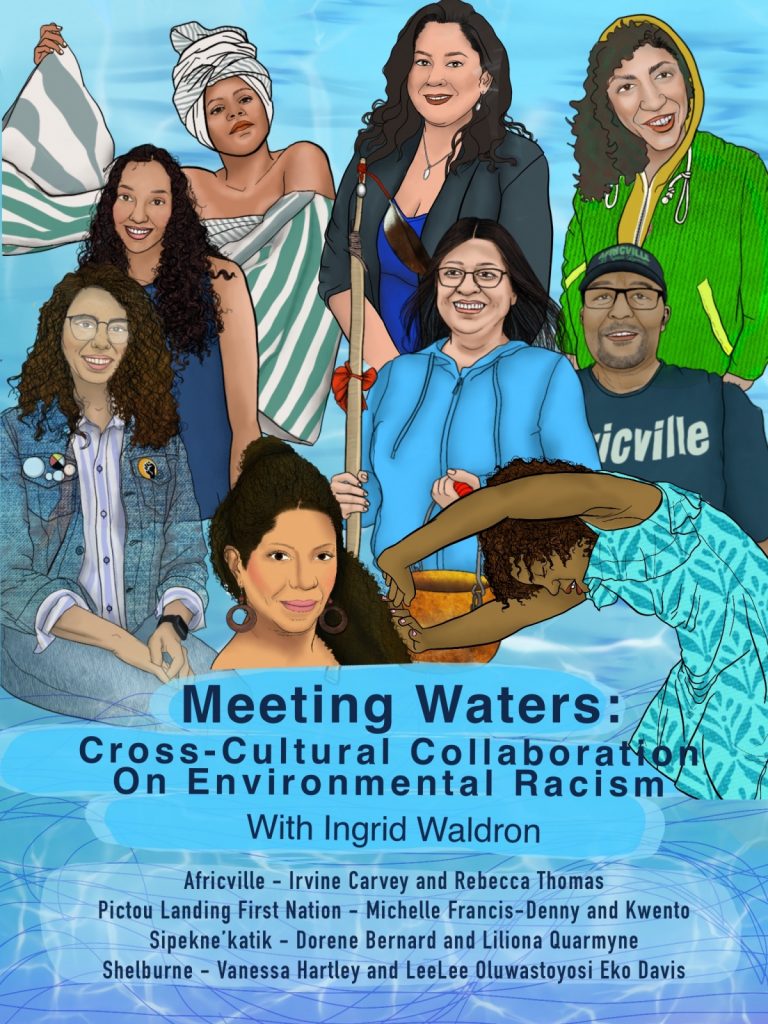
This event occurred on October 14th 2020, as an Anchor project of Nocturne Halifax.
Meeting Waters: Cross-Cultural Collaborations on Environmental Racism with Ingrid Waldron was an online event centering Black and Indigenous solidarity through cross-cultural exchanges on environmental racism in Mi’kma’ki. Speakers and performers were brought together to share stories and experiences of environmental racism through storytelling, dance, spoken word, song, and graphic art. Collaborators describe their experience and presented their original creation in the form of a Zoom event followed by a panel discussion presented in partnership with Visual Arts Nova Scotia.
Featuring collaborations:
Africville – Irvine Carvery and Rebecca Thomas
Pictou Landing First Nation – Michelle Francis-Denny and Kwento
Sipekne’katik – Dorene Bernard and Liliona Quarmyne
Shelburne – Vanessa Hartley and Leelee Oluwatoysi Eko David
Design and graphic recording by Bria Miller
With support from Lindsay Dobbin & I’thandi Munro.
0:11 LINDSAY CORY
Kwé and Hello. Welcome to Meeting Waters: Cross Cultural Collaborations on Environmental Racism. My name is Lindsay Cory, I’m the director of Nocturne and before we begin I would like to acknowledge that I am an uninvited guest to K’jipuktuk here in Mi’kma’ki. While this event is taking place virtually the Nocturne: Art at Night festival takes place in K’jipuktuk, the ancestral and unceded lands of the Mi’kmaq people. This land, and the waters that surround it, are covered by the Peace and Friendship Treaties signed between the British Crown and the Mi’kmaq, Maliseet, and Passamaquoddy peoples in 1725 to 1779. The 1752 rendition of that treaty is what governs K’jipuktuk, where I am coming from today. We are all treaty people. That means that we have a shared responsibility to uphold the agreements laid out in those treaties. Furthermore, we have a responsibility to stand in solidarity when those treaty rights are in question.
I also want to acknowledge the significant foundations in infrastructure and culture that Black and African Nova Scotian communities have played in building this province and country. Nocturne stands with Mi’kmaq grandmothers, land and water protectors, and social justice seekers. As I learn more about this place I am committed to using my platform through Nocturne to amplify, connect and collaborate with the many art communities that live and work here in Mi’kma’ki.
Nocturne is also dedicated to providing safer spaces at our events and gatherings – even the virtual ones. Our aim is to host spaces that are widely accessible, amplify marginalized voices and leadership, and actively prioritize anti oppressive principles wherever we can. That said, we can’t promise a totally safe space for all tonight. If you are experiencing any difficulty or need support, you can reach out directly to me in the chat and my name is Lindsay Cory again.
We also have a technical support assistant you can access and their name in the chat is TECH SUPPORT. You can message them directly if you are having issues connecting and they can try to help. If you can’t find TECH SUPPORT, then message me and I’ll try to help you as best as I can. We are also very grateful to Karen Staples and Ayoka Junaid, our ASL interpreters, for their work this evening and prior to in preparation for this event. Let us know if there is anything else we can do to make your access to this event more barrier free. Where possible we’ll be adding text to the projects that you’ll be witnessing tonight in the chat so you can access those, all. If you want to move your chat to the side of your screen for better viewing you can do so by turning off your fullscreen if you’re using a desktop and that should move it to the side for you. If you’re looking for the chat button it’s right at the bottom in your toolbar.
Your host tonight is Dr. Ingrid Waldron. Ingrid is an Associate Professor in the Faculty of Health at Dalhousie University, the Director of the Environmental Noxiousness, Racial Inequities, and Community Health and the director of The ENRICH Project. Her research, teaching, and community leadership and advocacy work in Nova Scotia are examining and addressing the health and mental health impacts of structural inequalities within health and mental health care, child welfare, and the environment in Indigenous, Black, immigrant, and refugee communities. I wanted to thank Ingrid for her leadership in this project and her guidance throughout the whole process.
Lastly, I’d like to thank our curator, Lindsay Dobbin who collaborated with Ingrid to conjure up this expansive project. I also want to thank our project coordinator, I’thandi Munro, who has been a dedicated collaborator throughout the process. Each of the speakers you will hear from tonight will be introduced by Ingrid and they have brought so much grounding and passion to the process. I really just want to thank you all for working through this with us.. And with that, I am very pleased to welcome you to Meeting Waters: Cross Cultural Collaborations on Environmental Racism. I’ll pass it over to Ingrid.
5:20 INGRID WALDRON:
Good Evening everyone. I would like to welcome you to Meeting Waters: Cross-Cultural Collaborations on Environmental Racism.
I would like to begin by acknowledging that we are in Mi’kma’ki, the ancestral and unceded territory of the Mi’kmaq People. This territory is covered by the “Treaties of Peace and Friendship” which Mi’kmaq peoples first signed with the British Crown in 1725. The treaties did not deal with surrender of lands and resources but in fact recognized Mi’kmaq title and established the rules for what was to be an ongoing relationship between nations. We acknowledge this land not only in thanks to the Indigenous communities who have held relationship with this land for generations but also in recognition of the historical and ongoing legacy of colonialism.
The collaborative pieces between speakers and performers that you will see this evening ask an important question: How do we forge meaningful relationships and build solidarities across differences by listening and through self-reflection to create the necessary partnerships that allow us to challenge environmental racism and other land-based struggles that have harmed the land, our communities, and our well-being?
Over the next hour and half, we will centre Indigenous and Black solidarities through cross-cultural exchanges on environmental racism in Mi’kma’ki.
We bring together speakers and performers to share stories and experiences of environmental racism and other land-based struggles in Mi’kma’ki through storytelling, dance, spoken word, song, multimedia performances, and graphic art in four communities. These communities are: Africville, Pictou Landing First Nation, Sipekne’katik First Nation, and Shelburne.
Let’s begin with Africville. Irvine Carvery was born in Africville to a large family who were landowners and community leaders. He was the President of the Africville Genealogy Society. Under Carvery’s term, the Africville community received an apology from the city of Halifax for the razing of the area in the 1960s. The Africville church was also rebuilt.
Rebecca Thomas is an award-winning Mi’kmaw poet. She is Halifax’s former Poet Laureate (from 2016 to 2018) and has been published in multiple journals and magazines. I’m Finding My Talk is her first book. For Thomas, a Mi’kmaw woman whose father is a residential school survivor, poetry has served as a powerful tool for educating about the racism and the inequality that still haunts many Indigenous peoples in Canada. She has two books slated to be released in the fall of 2020.
I will read their piece. Their piece is called The Planning of Environmental Racism in Africville. This is a collaborative piece by Irvine and Rebecca. A fertilizer plant and city dump are just two examples of how the city of Halifax took the most harmful and unwanted pieces of infrastructure and placed them next to the vibrant community of Africville in a long legacy of environmental racism in Nova Scotia. From the chemical with water sprayed on the unpaved roads of the community to the unsafe levels of soil toxicity in 2020 from that very water, this legacy is one of Canada’s ugliest. However, the spirit of Africville lives on, its former residents and its descendants also live on. Irvine and Rebecca will deliver an oral history of and spoken word piece on Africville respectively. Welcome Irvine and Rebecca.
10:24 REBECCA THOMAS:
Hello, thank you for having me.
10:27 IRVINE CARVERY:
It’s a pleasure to be here indeed. Rebecca and I have worked together on this and I’ve agreed to go first. First of all I want to acknowledge the ongoing struggle of my brothers and sisters in the Mi’kmaq community. Tonight as we speak, they are exercising their rights for self government in declaring their own fishery and the establishment continued to deny their rights. We stand in solidarity with our brothers and sisters. It’s going to be a long struggle, but we will stay in the struggle with them, until self governance has been fully achieved by my brothers and sisters. The topic of Africville environmental racism and the reason why we use the title ‘The Planning of Environmental Racism’ is because that’s exactly what it was. In the mid 19th Century, <inaudible> of slavery, there began a new type of discrimination and it was called scientific racism in which science was used to downgrade people of African descent to be less than white people. Planning became the focus point for, or it should have been the focus point for, the betterment of lives of people in Halifax in planning institutions, play spaces, recreational spaces. But because of this scientific racism, Africville was not considered to be important enough – or we were not considered to be on the same par as white people here in Halifax – so when planning for the unwanted services for the greater society, the placement of those services was put in and around Africville. Beginning in 1870, with the siting of an infectious disease hospital directly above Africville with its sewer line running down to the shores of the Bedford Basin in Africville, emptying at the high water mark. That was the beginning. The railroad went through Africville, dividing our community and taking our land, and all of the smoke and the filth coming from the railroad going through your community was inflicted upon the people of Africville. Slaughter plants. Fertilizer plants. And we know fertilizer is detrimental to the environment, all we have to do is look at the bombing with fertilizer being used as an explosive. There was a quarry built in and around Africville. The dumping of human waste was done above Africville, in Africville I say. All of these unwanted services for the city of Halifax, by the planning department, the planning department looked in their planning to better the lives of the citizens of Halifax. The planning department looked around the city of Halifax and many locations were rejected because of health concerns. Those same concerns were not afforded the people of Africville. They were placed in Africville. 1950. 1955. The city of Halifax had to relocate its open dump and again, once again, sites were looked at and rejected because of health concerns. That dump was placed in Africville 300 yards from the nearest home in Africville. People in Africville became sick from that dump. People from Africville died because of that dump. All of the toxic waste in Halifax, waste coming from not just residential areas but all of the industries, all of the hospitals, was dumped on that site 300 yards from the nearest home in Africville. My oldest brother was killed by a truck going to that dump in Africville. He was 12 years old. If the dump wasn’t there, my brother may still be alive today. Poison was brought to the dump in Africville and given to the men who worked on the dump. Those men took that poison home and mixed it with their seed beer and three of them died because it was poison. There was an inquiry held as to found out what happened. The inquiry concluded that it was not the makers of the poison who was at blame, it was not the deliverers who was to blame, but instead it was the victims who were to blame because there was a bylaw in Halifax that stated that people were not allowed on the dump. That was the findings of the inquiry. We’re talking about the 1960s, we’re not talking about the 1700s or the 1800s, we’re talking about the 1960s. You see, we as people of African descent in this city have always been treated as lesser than. The destruction of our community began, or the planning of the destruction of our community began, in 1915. Not in 1960 when they came in and destroyed it, but in 1915 with the planning of the destruction of our community. But it was not enacted until the 1960s. So we had to live with all of this industrial waste, all of this pollution. Ingrid in introducing us talked about the road systems in Africville. Where the pavement ended, Africville began. And they used to come out in the summer time to spray down the roads to keep the dust down. They sprayed it with some kind of a mixture. Now we’re talking about the 1960s. We did an environmental study in 2010 to find out if the land was environmentally friendly, and in 2010 the remnants of that poison that was poured on our roads was still present to the point that it was recommended that no one live there over a 24 hour period because the land was still polluted. That’s what we had to put up with. And the reason why? Because they didn’t see us as equal. We were less than. We were no longer slaves, but we were still treated as slaves, as chattel. We were disposable. Our land was disposable. The city of Halifax and their planning department felt that our land was underutilized, so therefore the value in the land wasn’t there for the city of Halifax, so they had to get us out of there so that they could get the true value of that land for the coffers in the city of Halifax. But still, the land sits empty and it will still stand empty until it is returned to the people of Africville. Thank you very much.
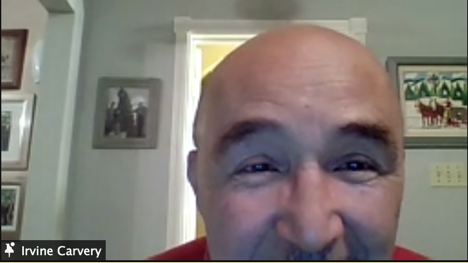
19:30 REBECCA THOMAS:
We’lalin, and thank you so much, Irvine, for that, and I hope that my poem honours what you said, honours you, and honours the descendants of Africville. So with that, I’ll begin.
This is isn’t my story.
But I’ve been placed in a position.
I have the honour to tell it.
And I implore that you listen.
This isn’t my story.
But I feel a connection.
Don’t miss this chance to be taught a lesson.
It’s about resilience and lineage.
Unbroken by those born into privilege.
Let’s set the scene.
Paint a picture of a little place, east on the continental map.
Where we have a vibrant Black community and city council fat cats.
Because of their Loyalty to the crown,
Because their melanin was on the other side of brown,
Because they had escaped to freedom and would never go back.
Because they were Black,
The city of Halifax planned it’s attack.
In order to control a race,
You need to control a space.
And control the space they did.
They began by denying services.
They viewed the community as nothing but squatters.
The year the Baptist church went up, the mayor of the time went on to found Halifax Water.
Ensuring Halifax residents a safe drinking supply was the mission,
For this newly established commission.
Who wilfully ignored the Campbell Road Settlement’s petitions.
If only running water was the soul denial.
But Halifax had plans that were much more vile.
A railway bisected Africville’s streets.
Who was responsible?
Raise a glass for the Mayor of the time, Mr. Alexander Keith.
Next came the hospital full of infectious disease.
That filled the community with a sense of unease.
Then a prison to overlook the residents.
That left a correctional legacy rooted in prejudice.
Where decedents are carded and harassed
Because their homes were razed from the grass.
With Africville continuing to grow,
The city calculated it’s next blow.
While toxic chemicals were sprayed on the unpaved streets,
Children followed along on their bikes at top speed.
Into the earth those chemicals leached.
In 2020 can still cause disease.
Decision after decision,
Cut the teeth of politicians,
These transgressions were targeted,
The harm was marketed,
As though it were benevolent help.
Toasted with water from poisoned wells.
This was methodical.
This was logical.
It’s a matter of historical fact!
The evidence is stacked.
They went from self-sufficiency to government dependency.
A people’s humanity was reduced to policy.
White council members voted no on Black survival,
A throwback reference with modern day revival.
Sewer pits and a slaughterhouse
A city dump and future freeway routes.
No amount of engineering could bridge the gap
Between was what taken and what can never be given back.
Their taxes paid for the garbage trucks that moved them.
To where white neighbours angrily refused them.
Broken promises of relocation funds.
Calling their home the city’s worst slum.
Halifax thought they were nothing but weeds.
And it might of damaged the tree when it cut off the leaves,
But Black roots are known to grow deep.
Whole communities sprung forth from the scattered seeds.
No amount of racism could quell the uprising,
At this point, Black success shouldn’t be surprising.
Because Halifax poisoned, destroyed, isolated and denied everything they could.
But the spirit of Africville lives on in neighbourhoods.
The square and the park are full of laughter.
Descendants are writing the next chapter.
Through professing and politics.
In their athletics and kinetics.
Speaking their truth in Scripture.
Blowing minds in art and literature.
Are you now finally getting the picture?
You can move the people and take away their things.
And I’ll point to 1000 examples of how they were and will always be amazing.
But this isn’t my story
And even though there are tales of glory
Of success and triumph,
We can never forget what was done.
To a community that committed no crime.
Whose land was eroded, taken and razed over time.
This isn’t my story but I’ve been asked to tell it.
About a community whose descendants will never forget it.
The colonial beast may have sharpened it’s teeth on our hides.
But from an L’nu to a Scotian, I see that twinkle in your eye.
Because we wrote the books on how to survive.
Then delivered a masterclass on how to thrive.
So from the pen of a Mi’kmaw poet, I put forth a motion.
That Africville be remembered and paid it’s due by every single Nova Scotian.
Thank you. I hope you liked that, Irvine.
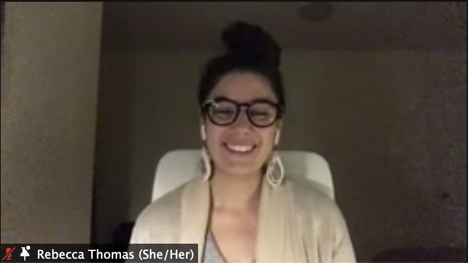
24:08 IRVINE CARVERY:
Oh my God. You’ve got to send that to me. That is <inaudible>. Thank you, Rebecca. Thank you, thank you, thank you.
24:16 REBECCA THOMAS:
We’lalin. Thank you so much.
24:18 IRVINE CARVERY:
We’lalin.
24:19 INGRID WALDRON:
Wow. Thank you, Irvine and Rebecca, that was wonderful. So let’s move on to Pictou Landing First Nation.
Michelle Francis-Denny is the Community Liaison with Boat Harbour Remediation Project but first and foremost she is a Pictou Landing First Nation community member. Pictou Landing First Nation has suffered from decades of pollution and most recently worked with various allies to pressure the Nova Scotia government to pass the Boat Harbour Act, which put an end to the Northern Pulp mill in Pictou County using Boat Harbour as an effluent treatment facility.
With a unique sound crossing Neo Soul and Experimental R&B, singer-songwriter Kwento embodies empowerment through presenting an honest ode to her femininity and Afrocentricity. Kwento receives the energy of her audiences and returns it tenfold – through her soulful vocals, effortless performances and vibrant aura. As her talents take her across the globe, Kwento is collaborating with producers in South Africa, writers in Germany and musicians and producers in Toronto and will release her second EP entitled ‘abbrv.’ (abbreviation) this year.
Kwento and Michelle’s piece is titled Purple Tides. Purple Tides is a presentation about the community members of Pictou Landing First Nation who have fought tirelessly for more than 5 decades to stop toxic pulp mill effluent from being dumped into their backyard. One of the major visual impacts of the mill operations since it began in 1967, was the presence of foamy effluent washing up on the once pristine beach turning the tides purple. Boat Harbour or A’se’k (the other room) the elders called it, was no longer a place they could rely on for their resources and a void was created in the lives of community members. The Boat Harbour act ordered the effluent treatment facility to close in January 2020 and a new chapter began. Michelle and Kwento have come together to highlight the depth of the impact of this atrocity. Through a speech and a performance of an original song, they will shed light on the healing journey ahead for the community. Welcome Michelle and Kwento.
28:02 MICHELLE FRANCIS-DENNY:
I want to thank you so much for inviting Kwento and I to collaborate on this project for this very worthwhile event. It’s going to be an amazing week. I’m a very proud member of Pictou Landing First Nation and it just so happens that my very personal ancestral connection to the Boat Harbour crisis was highlighted in the film There’s Something In the Water. Our community is very proud to have had this story elevated on such a level that it has resonated with people all over the world and we’re able to help bring awareness to environmental racism. It’s very important for me to acknowledge that every single person in our community and our leaders, those that are here now and those who have passed, each have a story and every single one of those stories matter. Our stories are each a little bit different but connected by the fibres of our being and our strong sense of community. We’re bound by our resilience and our bodies are filled with ranges of valid emotions and trauma. The pulp and paper waste treatment facility has definitely impacted us and those impacts run exceedingly deep. As you can tell in the film, our elders tell many stories and they talk about how the impacts of 1967 were immediate. And how fish immediately died and washed up on the banks and the water turned brown and the stench in the air where, even if you were to venture inside, you couldn’t escape from it. The chemicals in the air and the elders talk about the houses, the paint on the houses, turning black. You think about all those things, but you really need to think about what lies beneath the surface of what you can see. How much anger and sorrow and resentment and sadness our elders must have felt to witness that and how they carry that with them through their lives. The inter-generational impacts that are being carried on. The loss of our Mi’kmaq culture and our pride essentially being washed away with those purple tides. It is quite upsetting how the water authority was very intentful in provincial government. They knew exactly what they were doing. Preying on a vulnerable and marginalized group, using such lies and deceit. Our leaders fought for this case of environmental racism to be recognized, just to be seen, and corrected for many decades. To tell you the truth, the last five years have been a true testament to our strength. Being tossed into this whirlwind and we’re still suffering the effects, but in the pursuit of environmental and social justice it was well worth it. This year, in 2020, we’re finally able to rejoice and celebrate with the closure of the effluent treatment facility that was piped across Indian Cross Point and right into our back yard at Boat Harbour which the elders once called A’se’k. I think about the lengthy battle that’s coming to an end and after the dust settles, a solemn battle within ourselves and within our community needs to be recognized because something new is beginning. Now we’re being tasked with creating a new legacy and a new beginning for future generations. So we look ahead, we talk about our healing journeys a lot, but we’re reminded of the medicine wheel. As Indigenous people we want to strive to achieve balance in our lives and we want to heal from the trauma we’ve endured. So we think about the physical, the spiritual, the mental, and the emotional well-being, but there’s still uncertainty for us that’s in the back of our minds. So we’re not so certain what the way forward is. So many questions alone. I’ve heard from the community: ‘What does healing look like? How am I supposed to feel? Will the fish come back? Who will teach me to hunt?’ We’ve lost that skill, in some sense of passing it down to our generations. ‘Will I be able to dip my toe in the water without fear? Who can I trust?’ Only time will tell.
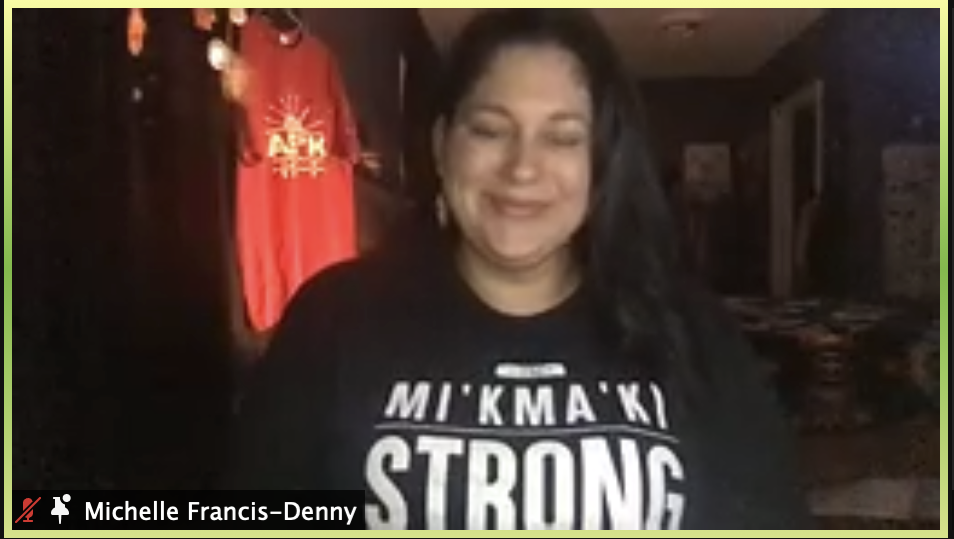
33:27 KWENTO’S PRESENTATION:
Waves of change keep growing
Crashing on the surface, level still
Rivers of pain keep flowing
From the corners of the Earth and into our veins
These waters, they know us by name
They know why we came, they have all the answers
We’re learning, learning to swim
Teach us to swim, we’re learning to swim
Beyond the purple tide, beneath the ocean floor
After the battle we, after the battle we find, we still find
We still find
Hear them say, we’re finished
No mountains left to climb
Where is our beginning?
Running out of time
These waters, they know us by name
They know why we came, they have all the answers
We’re learning, learning to swim
Teach us to swim, we’re learning to swim
Beyond the purple tide, beneath the ocean floor
After the battle we, after the battle we find, we still find
Beyond the purple tide, beneath the ocean floor
After the battle we, after the battle we find, we still find
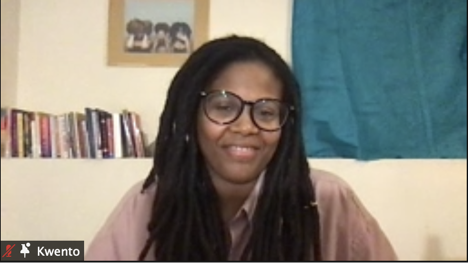
37:18 INGRID WALDRON:
Beautiful. This was really a great idea to do this event! Really great. Thank you, Michelle and Kwento. So let’s move on to Sipekne’katik First Nation.
Dorene Bernard is a Grassroots Grandmother, from the Sipekne’katik Band in Mi’kmak’i. She is a Water Protector, a Water Walker, and Survivor of the Shubenacadie Indian Residential School. Her background is in Aboriginal Social Work where she worked for 20 years in Child Welfare and Community Support for Residential School Survivors. She was the Coady International Institute Chair in Social Justice in 2017, sharing her teachings on Environmental Racism, Climate Change, Residential School legacy, Missing and Murdered Indigenous Women and Girls, and Water teachings. She has been inspired and was mentored by the late Grandmother Josephine Mandamin, Mother Earth Water Walker.
With an eclectic background that has taken her through many performance styles on four different continents, Liliona Quarmyne is a dancer, actor, singer, community organizer, and activist. She performs across Canada and internationally, creates original works as an independent artist, facilitates community programming, and is the Artistic Director of Kinetic Studio. Liliona sees her body as a link to past and to future generations. Her scope of work is broad but is particularly focused on the relationship between art and social justice, on the body’s ability to carry ancestral memory, and on the role the performing arts can play in creating change. Welcome Dorene and Liliona.
39:55 LILIONA QUARMYNE:
Good evening everyone. Before I introduce our piece, I just want to give deep gratitude to Doreen as she joins us tonight from the front lines at Saulnierville and to acknowledge the incredible heart and care she has put into creating this piece as she has been fighting on the front lines. We’lalin Doreen.
Our piece, part teach-in, part dance, part offering, and part prayer. This performance piece touches on Alton Gas and the establishment of the Mi’kmaq Treaty Rights-Based Fisheries. Drawing on the Peace and Friendship Treaties, this piece will share the ways in which the actions of corporations and large commercial fisheries contradict our collective responsibility to live as treaty people.
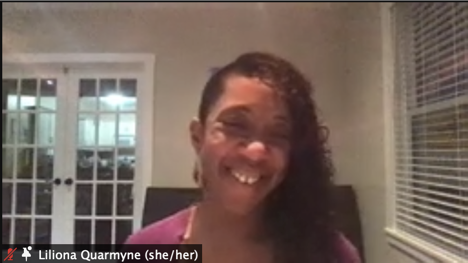
42:52 LILIONA QUARMYNE & DORENE BERNARD’S PRESENTATION:
<Speaking/greets in L’nu language> My spirit name is <Introducing self in L’nu language>. My name’s Dorene Bernard, I’m from Sipekne’katik, <Introducing clan in L’nu language> clan and Mi’kmaq. In our teachings, water is life. We were given a gift, to bring life forward, to carry life in the womb, surrounded by water. The water is our first world. We can breathe the water, drink the water, we are the water. When we’re born, we come through the water. The water hears our dreams, hears our thoughts. The water is alive, it’s a spirit, it is our first medicine. With that gift, we’ve been given that sacred responsibility to take care of the water. We’re here to protect the sacred, not only for us, but for our future generations. I would like to see more people have a relationship with the water. Tell the water ‘I love you, I thank you, I respect you.’ Water is life. Our Peace and Friendship Treaties, they are a covenant chain of treaties that took decades to be ratified. And at that time in the 1700s we travelled throughout America, throughout Mi’kmak’i, to tell the people, to consult the people, to tell them that these treaties lived. So it did take years, because we travelled by canoe, we travelled by water, we travelled over land, walking the land. Many people look at our treaties as separate, but they’re all one continuous treaty. <inaudible> our own fishery where moderate livelihood <inaudible> use our lands and resources for the good of our people and to implement those into law. We have treaty rights and we are going to assert those rights. We are all treaty people. What does that mean? That means that we are living here together. This is our land. We share our land with you. And it means that you have a responsibility too. Standing on the shore, <inaudible> leave the wharf. Surrounded by hundreds of non-Native boats. <inaudible> I have such a deep pain in my heart. Our boats that went out there among those hundreds of fisherman, with big big boats compared to ours. And how they chased them and surrounded them and intimidated them. Many turned around and hauled all of our traps out of the water. We knew we had to do something about that. Called DFO, the Department of Fisheries and Oceans, and the RCMP looked on and did nothing. <inaudible> They said it was too dangerous for them to be on the water, that says a lot about how much control they had over non-Native fisherman. Using their boats in a dangerous way, stealing gear, doing all the things that break the laws of the fishery. Not only for DFO regulations about also their own unspoken laws: you never touch another person’s gear. It’s not about conservation, it’s not about fishing in a different season. This was only racism. Them thinking they have ownership of the fishery and these are their waters and these are their fish and we were interfering with that. They just came out from everywhere. We know that racism is alive and well. It’s systemic racism, it’s not just in the fishing industry, and it’s not just the corporations. Alton Gas, but also gold mines and the mining that they want to do coming into our communities, on our lands, on our territory, that want to do business and bypass the consultation <inaudible> informed consent of the Indigenous peoples. But it’s also in the health system, the justice system. Pretty ingrained in Canadian society. We’ve lost decades of history. This isn’t something that I learned in residential schools. This isn’t something my parents or grandparents learned in residential schools. We are living this education. We are living this history. Many fisherman and those families down there, really don’t have the education on our rights as the Mi’kmaq people. Many people were educated during those three weeks, for sure. I know they read the treaties. I know they were looking for what these meant. So it was really something that was long needed, maybe this was a wake up call for them as well. As we were asserting our treaty rights they were trying to figure out what those rights are. And it’s important, really important, that these teachings about our treaties are taught in the schools. Taught in the governments and the organizations. It’s very important that people embrace the meaning of what it means to be a treaty people. We have a lot of catching up to do and a lot of healing of relationships because our treaties have not been implemented and it’s the government that has stopped those things from happening. And now we are implementing, we are serving our treaty rights, we are just doing what needs to be done, for the good of our people the Mi’kmaq and the Wabanaki people who are represented in those treaties. We are unified now to implement those treaties with our laws, with our governance, and not just rely on the Canadian government to define what it means. We need everyone to look at the UN Declaration of the Rights of Indigenous People and the Truth and Reconciliation Calls to Action. The UN Declaration is in thirteen of those ninety-four calls to action. The government has the blueprint, has a foundation, in those documents, to also implement those treaty rights into law and that’s what needs to be done. That’s where we are today. We are at this place in 2020, there is no turning back. We only can go forward and we’d like to go forward together. 2020 is the year of change and it’s going to be for the better.
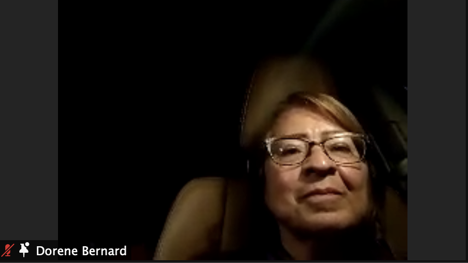
52:27 INGRID WALDRON
Thank you, Dorene and Liliona for that beautiful piece called Salt Fish. Incredible. Let’s move toShelburne.
Vanessa Hartley is an 8th generation Black Loyalist descendant from Shelburne, Nova Scotia. Currently, she works for Shelburne Association Supporting Inclusion (SASI) as a Community Support Worker. She recently completed her diploma in Social Services and is currently working on community development presentations, programming, and other projects for African Nova Scotians in Shelburne. Vanessa also sits on the board of the South End Environmental Injustice Society (SEED) in Shelburne.
Leelee Oluwastoyosi Eko Davis is of Nigerian, Trinidadian, and French descent. They are a disabled, genderqueer intermedia artist. They are from Treaty One Territory in Winnipeg, Manitoba. Leelee also works as a program designer, facilitator, and consultant in the field of Social Innovation and Adaptive Change. Welcome, Vanessa and Leelee to present their piece.
54:21 LEELEE OLUWASTOYOSI EKO DAVIS:
Thank you, thank you. Thank you, Ingrid for the vision of this work coming together in the way that it has. Yeah, feeling really very blessed. Our piece today we’re sharing with you, Vanessa Hartley and myself, is called . It examines environmental violence that’s afflicting the Black rural communities of Shelburne. The impacts that environmental racism is having as demonstrated here is very real and is very tangible and very urgent. Shelburne’s rich history illustrates the systemic barriers that the community has faced and continues to face today. We, Vanessa and I, have asked ourselves: can these trials be overcome? How can resolution and faith carry us through these continual acts of violence? Where can we go to find solace in these turbulent times? We are sharing this through storytelling, film, sound, and movement, and we’re just going to take some time with these questions. That was our intention with this and not because we think we’ll find answers, but as a means to engage our spirits and our continued liberation in this powerful, powerful way that we are here together. Black, Indigenous, solidarity, liberation, sovereignty, together. Thank you. Hope you enjoy.
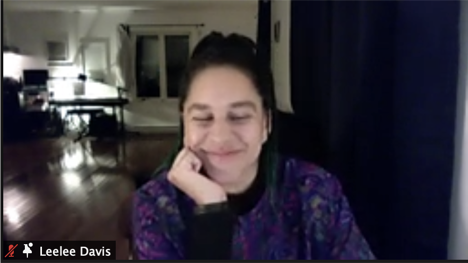
56:22 LEELEE OLUWASTOYOSI EKO DAVIS & VANESSA HARTLEY’S PRESENTATION:
Affliction
Affliction
Affliction
Afflictions
Afflictions that cut so deep, it harms the generations ahead
Afflictions that cut so deep, it harms the generations ahead
Speaking up to disrupt the cycle
Speaking up to disrupt the cycle
Speaking up to disrupt the cycle
Speaking up to disrupt the cycle
Speaking up to disrupt the cycle
Speaking up to disrupt the cycle
Speaking up to disrupt the cycle
Speaking up to disrupt the cycle
Speaking up to disrupt the cycle
Of inter-generational trauma
You said get over it
Environmental racism
Environmental racism
Environmental racism
Environmental racism
Environmental racism
We want water that won’t kill us
Your response, is to stop using the race card
We protest, speak, and fight in hopes to gain respect and equality
These afflictions that cut so deep
These afflictions that cut so deep
These afflictions that cut so deep
These afflictions that cut so deep
Our Black community is located in the South End of Shelburne.
Historically many loyalists settled within town limits along the waterfront.
Black loyalists would soon join and live within the outskirts of Shelburne.
Shelburne is where the first race riot within North America would happen.
Riots lasting up to 30 days. Homes, churches and everything else was burnt.
Black loyalists would then settle outside of Shelburne on the outskirts as well within
Birchtown and South End.
From the beginning our community was displaced and marginalized.
Our problems all start from historical presence.
We need to evaluate Shelburne as we still have many systemic barriers that our people are facing.
Shelburne creates these afflictions that run so deep within our history.
How can we establish our land?
When is this toxic inequality depreciating the value of our homes?
Dispense asbestos and chemicals into our wells and takes our elders all too soon.
This land, once a dream, a promise of freedom, is going to kill us.
It becomes quite challenging when town council is reluctant acknowledge environmental racism as a concrete issue.
South End Shelburne residents are perceived by town council as unvalued.
If our council cared of the health and well-being of the South End residents, they would have brought forth the ability and accountability to provide clean drinking water to our residents.
Blessedness I feel, it meets my skin with a warm glow.
The body of a Black woman feels many things.
Blessedness gives me permission to feel joyous.
This new state of self love is what they fear.
And like, some of the elders in the community talk about watching it burn and having to go to school smelling like that, and asking why they smelt so dirty and being sent home because of it. So it’s definitely impacted a lot of generations, I would say. Yeah, like, the toxins were going down into the wells so they’re getting that deep that they’re able to reach the water tables and there’s like super high levels of lead and asbestos in the water here. And there’s a lot of individuals that have passed away from multiple melanoma which is like a super rare type of cancer. And it’s so weird that this one little clump of Shelburne, everyone’s suffering from that one type of disease. But there is something in the water.
And what are the local politicians like?
Well, I think it was 2017 when this was in the midst of happening, um, the town councillor had said that this community, the Black community, needed to stop using the race card. So, they’re not even recognizing that environmental racism is alive and well in Shelburne, let alone being told to stop playing the race card when all we’re fighting for is clean drinking water that every human should have and everyone should have the right to. So it’s been challenging in that sense of just having the story told and people trying to understand and wanting to listen.
It doesn’t make any sense and to dis-acknowledge that we don’t have a Black community as well.
What?
Yeah. Our mayor dis-acknowledges that we have a Black community in Shelburne.
He says there’s no Black community here?
Mmmhmm.
So basically, your family, all of your descendants, all that, you just don’t exist.
Yup.
Yeah, it’s there’s a lot of like white history that’s shown on the waterfront cause of like the loyalists themselves. There’s nothing to do with Black loyalists, yeah.
But what really struck me is that there was nothing, at all about any Indigenous population, like has been completely completely erased from the storytelling, from the time lining.
But we know they were here first, so what happened? And a lot of the times, my, it would have been my grandmother Clara’s side was First Nations. She actually had, was a part of, um, like the reserve, she lived on the reserve and she married, or had children with, my grandfather who was a Black man, so she lost all of her status. Yeah.
Our town council would have also brought forth an effort to establish and foster relationships within this community, as well acknowledge that there is a Black community in Shelburne.
Blessedness I feel.
Blessedness gives me permission to feel joyous.
This new state of self love is what they fear.
Blessedness I feel.
Blessedness I feel.
Blessedness I feel.
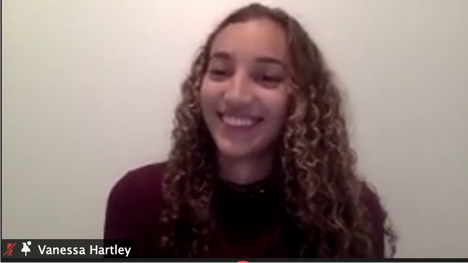
1:06:56 INGRID WALDRON:
Wow. Thank you, Vanessa and Leelee, for that haunting piece. Like all the other pieces, we didn’t know what we were getting. Life is like a box of chocolates. That was haunting and that was beautiful. Thank you so much. I would like to thank all of the speakers and performers for these wonderful, innovative, and incredibly creative performances and move to the final segment of our program tonight, which is a moderated discussion. I want to ask the speakers and performers to reflect on several issues, including their experiences collaborating together, what they learned, and how they think solidarities can be built through art and activism in Mi’kma’ki.
So let’s welcome once again Irvine and Rebecca; Michelle and Kwento; Dorene and Liliona; and Vanessa and Leelee.
I’m going to pose this question to everyone, so you can all certainly answer if you choose. The first question is really just to get a sense of what it was like, you’ve produced some really beautiful pieces tonight, and I’m pretty sure the audience wants to know, what was it like creating your piece and bringing it to fruition?
1:08:29 MICHELLE FRANCIS-DENNY:
I can start by just, I really enjoyed working with Kwento. I think it just flowed, and I think what I appreciate most about her is that she just listened. When we’re in such traumatic, and so much turmoil constantly, you know, I just kind of word vomit to whoever would listen. But she was really kind in listening to the things that were important to me and that really transitioned and I’m so proud of the piece, that she decided to do an original, and I’m very grateful that we were paired together. So thank you, Kwento.
1:09:16 KWENTO:
Thank you, Michelle. I loved working with you. I feel like we’re very compatible as people, you know. I just loved sitting on the phone and just chatting with you and hearing your stories. I was taking notes and making little pointers on the things you were saying. Yeah, the song wouldn’t have turned out if you weren’t so open and willing to be vulnerable with me and share what you really felt. I really appreciate that and I loved working with you too.
1:09:48 REBECCA THOMAS:
I was going to jump in really quickly. I called up Irvine and he just told me a story, and he told me the story of Africville and I took furious notes. With the poetry I do, and when I write, I’m very clear about my intentions that I never want to write stories that aren’t mine, or speak to stories that aren’t mine, and here I was doing a story that’s not mine. But, Irvine was so warm and trusting and he said ‘you know, I’ve been following you since the beginning and I know you’re gonna do a good job.’ So I put an incredible amount of pressure on myself to write something. I was very nervous because I asked him ‘do you want to review it before I do it?’ and he said ‘nope, you’re gonna do a good job and I want to be surprised with everyone else.’ So that’s kind of what my experience was. To have that trust was such an honour, I guess, because I’m not from Nova Scotia, I’m from New Brunswick, so the story of Africville was something that I learned after I moved here. So to have such trust in me was a really wonderful and warm experience.
1:10:57 INGRID WALDRON:
What about you, Irvine?
1:10:59 IRVINE CARVERY:
Trying to unmute here.
1:11:05 INGRID WALDRON:
You’re good.
1:11:08 IRVINE CARVERY:
Am I good? Good now. Oh great. Listen, you know what, we – it’s hard to describe, but we are all Indigenous peoples. Whether that’s an Indigenous person from Africa or an Indigenous person from North America. In our Indigenous-ness we share the spirit. We share in the love of the Earth and Mother Earth. Those are things that we share together. Even though we didn’t grow up together, we lived different lives, I know that that’s why I said to Rebecca, ‘I trust you. Because I know that you’re gonna be able to really really touch on Africville’ and I sent her a note telling her that she really does have the spirit of Africville. In listening to everybody collaborate and the collaborations of everyone here this evening, I’ve got to say that I’m so humbled and honoured to be a part of this group. This is absolutely fantastic and I know that viewing audience is only gonna grow. Because I’ll bet ya, everybody who watched this tonight, is just gonna go spread the word. So I wanna thank all you young people for allowing me into your lives for a day. It’s been wonderful. Thank you so so much. And Rebecca, you’re the best.
1:13:01 REBECCA THOMAS:
Thank you so much.
1:13:04 INGRID WALDRON
What about Vanessa and Leelee, what was it like?
1:13:07 VANESSA HARTLEY
I had such an amazing experience. Typically, I’m not that artistic, so being able to collaborate on this project and really open up with my story and the history of Shelburne was incredible. As well, to be paired up with somebody, ten times as incredible to be allowed to express that. It was incredible and I’m forever grateful for this experience.
1:13:37 INGRID WALDRON:
Leelee –
1:13:38 DORENE BERNARD:
Oh, I’m sorry, did I –
1:13:40 LEELEE OLUWASTOYOSI EKO DAVIS:
No, no, you go ahead Dorene.
1:13:42 DORENE BERNARD:
Oh my goodness, it was beautiful and I want to thank Liliona for putting this all together. With, just some of the things I sent to her, and doing the water song the other day, and just last minute – everything was last minute – and having to come here and not even see the video before we, you know, get a chance to download it because, you know, we’re at the pound here and on the front line. All the things that happened today, this has been so uplifting and really fed my spirit. I’m so thankful that she, I just love that she was at the water and dancing in the water. Yeah. It just really uplifted me and I pray that it does for everybody who watched tonight. All our collaborations, they were just amazing.
1:14:45 INGRID WALDRON:
Thank you. I apologize, let me go back to Leelee and her piece with Vanessa.
1:14:55 LEELEE OLUWASTOYOSI EKO DAVIS:
Oh, it’s all good. To be honest, like, I’m just so moved by Vanessa and who you are as a person and your openness and your willingness, like, it’s really really clear these times require us to move with love, with care, with trust. And you gave and brought all of that, and I’m grateful. I’m so so happy and lucky.
1:15:21 INGRID WALDRON:
Thank you. Liliona? Liliona?
1:15:32 LILIONA QUARMYNE:
Yeah. It was, I think our experience, because what we’re dealing with is so, so alive in this particular moment, well, I mean, I have just so much love and respect for Dorene. But the reality of what we’re doing and the importance of, the importance of the words that everyone shared tonight, just felt so real in the creation process. I think throughout it, I was just so aware of what Dorene was saying and the lived reality of how she is in the world, you know, that she was talking about water as it was like, in everything she was doing, she was embodying water at the same time. It was really, really beautiful and powerful to be able to witness that and to feel it.
1:16:38 INGRID WALDRON:
Great. I’m also wondering if you could talk about what you learned from each other in your pairing. About your respective communities. What did you learn? Anyone can take this one
1:16:57 IRVINE CARVERY:
Well, you know for me, it was special because my grandmother is Mi’kmaq. And I never got to know my grandmother, but through my mother I got to know her. And to hear my brothers and sisters talking, and my sisters talking, it just brought to life the memory of my grandmother and I am so appreciative of that. And I have such faith, it renewed my faith in young people, that they are so powerful. That they have a gift and I’m so glad that they had the opportunity to share it with the world. It’s just simply amazing.
1:17:52 INGRID WALDRON:
Thank you. Anyone else, what did you learn through this collaboration for the piece?
1:18:00 LEELEE OLUWASTOYOSI EKO DAVIS:
Leelee here. I, you know, it’s funny because it’s like there’s all these moments that led to this moment, where all this learning was happening. And I’m not from here, I’m ‘come from away’ as Nova Scotian Africville descendants would call it. And I have to be aware of that. You know, I was very very hesitant about how much my voice was in the piece, how much my image was in the piece, because I wanted to honour Vanessa and honour Vanessa’s story and connection to that place which I don’t have. I have it only through the invitation from Vanessa. So I’m just grateful for the teachings that I have been gifted and passed forward from my Indigenous loves and community, the love of my life, and you know, then to this moment here that prepared me for this. My teaching, my learning is that everything is preparing me for what is coming now where I am.
1:19:10 INGRID WALDRON:
Thank you. I’m thinking about, for all of you, the importance of building solidarity. With Indigenous people, it’s an often discussed topic here, in this province, but across Canada. Did these issues emerge in the production of your piece, and if it did, how so?
1:19:44 REBECCA THOMAS:
I think for me when I was working on the piece, and learning as much as I did about Africville, like recognizing that there’s so many similarities in the stories between the Mi’kmaq people here in Nova Scotia and Mi’kma’ki and along with African Nova Scotians, just seeing how, how often we as people were just discarded. You know, for convenience, for capitalism, for development, for colonization. And to have very similar, like, you know, the Shubenacadie Residential School that my dad went to and the Home for Coloured Children, you just see so many of these kind of like similarities and it just kind of creates this sense of, though we are different in where we come from, and our backgrounds, we still have this really strong sense of solidarity by, you know, not only just surviving, because I don’t necessarily like framing it in that way, but to thrive and to find success beyond simple survival and I think that’s a really unique and incredible piece. It just brings, I don’t know, for me it just makes me feel closer to, you know, understanding or at least having an inkling of an understanding of the Africville Nova Scotian experience and how it relates to the Mi’kmaq experience. It was just a lot of learning and I feel good about this project. Sometimes I finish a poem and I just feel blah, but I didn’t feel this way about this poem. I feel good about this poem.
1:21:13 INGRID WALDRON:
Anyone else? Building bridges, building solidarities, how did that come out, how was it highlighted in the piece?
1:21:22 DORENE BERNARD:
I think that in our piece that we did, in listening to, seeing others, it’s about, it’s a spiritual movement. We build, through our spirituality, our connection with the Great Spirit, with the land, with Mother Earth, the water, and others, you know, all living beings. We talk about our relationships, you know, our relationships with the land, the water, the animals, the , the geese, and all the other living beings. And it’s our human relationships that are suffering. You know, we don’t have a problem with all these other living beings. We don’t have a problem with us. It’s how we treat each other and how that is reflected with how we treat the land, how we treat the water, how everything else is valued in the world. We don’t have value for ourselves and for each other, this is what’s playing out in the world. I think, you know, we talk about the value of our lives, our spirits, you know, so I think that for me, spoke in all of these collaborations, and I think it’s what came through for me and I want to thank everyone for being a part of this with me and Liliona and with you Ingrid, thank you for all you do. You’re the water warrior, you’re the Mother Earth warrior, and I always thought that and I’m so thankful for all the work you do because you bring good medicine. You take medicine from other people to make something good and I want to thank you for that. All of you.
1:23:54 INGRID WALDRON:
I want to pose this question to the artists specifically, to Rebecca, Kwento, Liliona, and Leelee. As you know, you’re artists, so you know there’s a long legacy of art for social justice. So I just want to hear from you, to hear what you think the role is, the role of art is, in raising critical consciousness and enabling people to listen to one another and respond effectively. What’s the role of art for you in that?
1:24:34 KWENTO:
I would say art is everything. Art is like taking nothing, like, space and time and there’s nothing there, and boom – art – and there’s something. I feel like, you know, like it comes from a place beyond ourselves. So if we want to raise our consciousness, art is the way. The way. Creating and making. Something from nothing. All movements have either a chant, or they have a you know ‘we shall overcome,’ there’s always a song. You know, there’s always a song or like, some type of visual, or some type of something. Because art also doesn’t ask permission to enter us, it just does. I think art is like the way, actually, to create social change.
1:25:37 INGRID WALDRON:
Thank you.
1:25:40 LILIONA QUARMYNE:
If I could just add to that, that was one of the most brilliant things I’ve ever heard in my life. I think too that art has the ability to be both incredibly simple and incredibly complex at the same time. So it can enable us to feel all the different emotions, and all the different sides, and all the realities at the same time which I think is essential for the really complex change that we need to deal with in the world right now. Yeah, and I think sometimes, non-artistic processes don’t have that capability.
1:26:30 REBECCA THOMAS:
I think for me, when I think about art, as someone who is both an artist and also, like a, kind of process oriented, nerdy, policy brain. Like, I live in those two worlds, very much, all the time. I can try to have this very rational conversation with somebody, I can pick apart a strategy, or look at a policy piece and try to find its flaws, but often times when you think about these social changes, those are rooted in emotion. So I often talk about the head work and the heart work. I think the head work is the laws, and policies, and all of that stuff that helps things function through process. But the art is the heart work. And in order to get your head to work, you have to have your heart working too. So I think for me, it becomes like a really great additional tool for me to invoke a sense of duty or responsibility to change. So I try to, at least within my art, blend together both that head work and heart work in a way that I can kind of elicit change.
1:27:43 IRVINE CARVERY:
I’m not an artist, but art is our humanity. Through art, we find our human selves. And that’s, that is incredible because, you know, when we look at our histories as peoples, any great movement has been led by people coming out of the arts. I think of James Baldwin, I think of Maya Angelou, I think of Tyler Perry today and the work that they do in bringing forward those very, very tough issues but bring it in such a way to bring humanity to it. So art for me is my humanity.
1:28:40 INGRID WALDRON:
What about Liliona? Anything you’d like to say? Not Liliona, I’m sorry, Leelee.
1:28:50 LEELEE OLUWASTOYOSI EKO DAVIS:
Well, it’s pretty much all been said. I just want to say, I guess in addition, that we are all artists, you know. Like, there’s an artists way in everyone if they give themselves space to have it. And that not all artists have the desire or the intent to create through their own humanity. So we’re all making this choice to do this in this way, because I’ve seen many artists who don’t think about intention, who don’t think about output, who don’t think about historical context, who don’t think about any of that. So, you know, I’m just grateful that I wound up in this place, in this time, in this vessel. So 100% yes, bring me back into my body, I started as a professional institution trained dancer and I left it primarily because I was sick of getting patted on the back like ‘hmm, that was nice.’ And I thought, ‘blood, sweat, and tears for that was nice?’ You know I wanted to tell stories and do things in a deeper, bigger way, and I’ve been grateful to be able to find that. To touch presence, to touch people’s humanity, their consciousness, and leave them with something that they can then go with and inform their steps forward. Yeah, y’all said it, but I came and said some more.
1:30:22 INGRID WALDRON:
Thank you. I’d like to pose this question to the speakers. When I say speakers, I mean members of the affected communities: Irvine, Michelle, Dorene, and Vanessa. We’re talking about building solidarity, but as you know there are barriers to building relationships and solidarities between Indigenous people, Black people and Indigenous people, and other communities, there are real barriers in Mi’kma’ki and other parts of Canada in doing so. What do you think those barriers are, and how do you think those barriers can be overcome.
1:31:02 IRVINE CARVERY:
Hmm. Really serious question here, Ingrid. You know, really, the colonizer did a wonderful job in dividing and conquering. You know, they have done a wonderful job in the way in which they present opportunities for the African descendant community and the First Nations community. They’ve done a wonderful job to divide us, but through our learned experience that all of us have had in dealing with the colonizer, we are breaking down those barriers. You know, we talk about Africville, but we’ve gotta talk about Turtle Cove over in Dartmouth that was destroyed with the Halifax explosion, which was a Mi’kmaq community right across from us. And we shared, we went across that harbour back and forth, from Africville to the Mi’kmaq community, we intermarried. When we arrived here in Nova Scotia, with no supports, it was the Mi’kmaq people that taught us how to go into the woods to find the herbs that we needed, taught us how to fish, taught us how to survive here in this very, very unfriendly place. But over time, they divided us. We need to go back to that commonality that we have with each other and I, you know, the struggles that each of us have been through, the only thing, you know, that worries me, is that the colonizer will use the fact that First Nations people have treaties, so therefore we gotta treat them differently than what we treat people of African descent, because of that, we’ve gotta just say ‘no, sorry, you’ve treated us the same.’ You know, you called me a n*gg*r, and you called them oh that dirty old *nd**n. That’s our history, right. That’s common shared history that we have with each other and we need to recognize that and we need to come together through collaborations like what we’re doing here right now is the way in which we break down that control by the colonizer. We’ve got to get rid of his control over our thoughts and our minds. The spirituality in, when I heard Dorene talk, we talk about the need for us to build, you know, self awareness within our children. That we want them to be strong as young people growing up. That’s exactly what Dorene is talking about, and it’s through that shared history that we can get there. So, you know, we’ve got a lot of work to do, but we are beginning to see the light. We are beginning to walk the same path. And when we get on the same path all together, we are a powerful force. And we can move mountains.
1:34:30 MICHELLE FRANCIS-DENNY:
In my experience, when it comes to barriers, I’ve been working on the, you know, the Boat Harbour mediation project for more than four years now, so I’ve been working directly with the Nova Scotia government and the sector that is responsible for the clean up plans. And I can honestly say that there needs to be a lot of work to be done on the end of, you know, government representation. When you’re working with Indigenous communities because, you know, this word reconciliation gets thrown around so much to the point that it means nothing now. It means absolutely nothing to us, but they have this sense of pride, you know, to say ‘we’re working with this community and we’re reconciling.’ But in reality, you’re not. You’re not. There has to be more space. More space created for conversations. So, you know, we tend to deal with this facade, ‘oh, we’re listening to you.’ You know, you throw in a buzz word here and there to really, to try and capture peoples’ attention that we’re doing well and we’re paying attention. But in reality, on community levels, we feel a different way. And it’s important for government and those representatives that are assigned to acknowledge that. And I’ll tell you, it is a struggle to let anybody acknowledge that they could do better. And that’s the number one barrier for me, is I just want an acknowledgement that you can do better. And it’s impossible right now, so that’s all. So we can move forward. Let’s create space, but first you have to acknowledge that. Don’t hide under this facade that we’re gonna go, and you know, I’m gonna put on my rose coloured glasses and this is all gonna be lovely and we’re all gonna swim in Boat Harbour someday. No. There’s a lot of work here and pay attention and acknowledge. It is what needs to happen and if that has to go up the chain to whatever levels, you know, to ministers and project managers, just a whole slew of people involved, that aren’t paying attention. Something has to be done about that.
1:37:03 VANESSA HARTLEY:
I agree, and going off Michelle’s point, of them trying to throw us off of our path. I think the BIPOC population has an end goal and we have a goal of true equality and equity, and government loves to play the game of chucking a couple words in that makes it look nice and pretty to then distort our perception of what’s actually taking place. So I find, going off this question, I don’t see it as a lack of solidarity between Black and Indigenous because I think it’s always been there and historically we know that it was. I see the solidarity between these two groups uniting and trying to get this end goal and I think in Shelburne, the issue here, is we don’t have the relationship with our municipal, or our town, council. There’s a lack of trust there. I don’t trust that you’re going to tell my story correctly. I don’t trust that you’re intent is accurate. And I know it’s not, because I know that our community still struggles in accessing clean drinking water after being bypassed twice on town water well. So, we know that these things are here in place and we can see them, but they’re not being talked about so we know your intent is not correct and therefore we are continuing to have this conversation, therefore, speaking up for ourselves, trying to fight for what we should have, for what every human being should have, and that’s clean water, and being told ‘no, stop playing the race card, no, there’s no systemic barriers in your way, no, you don’t have health issues’ when we can see clearly that we have many elders in our community passing from cancer and other disease. So I don’t think, in the future, that this trust is going to be built overnight because for many years they’ve been here creating this horrible place of a hell in our Black community.
1:38:55 IRVINE CARVERY:
Very good, Vanessa. You know, I want to point out, how dare Sterling Belliveau – Belliveau, whatever his name is – dare to suggest to the First Nations people that they should stop for a year to negotiate with non-Indigenous fishers. How dare he. How dare the non-Indigenous fishers think that they should be at the table for discussions with the government and the Mi’kmaq people. How dare they. How dare the Premier of Nova Scotia come out and apologize to Black people about the justice system and appoint a committee where we had no input, there was no consultation with us whatsoever, he hand picked who he wanted to be on it. How dare they. How dare they do these, but they continue to do it because of their feelings of white privilege. It’s what it’s about. It’s about white privilege. They say these words, as Michelle said, but those words have no meaning. They have no meaning. And we need, we need, we – our peoples – need to see beyond those words and we need to demand. We are at a, it’s the 21st Century, no more asking for anything, it’s now time to demand and get out there and make it happen. So, that’s where we need to get to as people with our collaborations. We need to support each community strongly.
1:40:49 LEELEE OLUWASTOYOSI EKO DAVIS:
I don’t think people realize that the fight that we’re fighting is God’s work for everybody’s survival. Because when there’s no water, and there’s no land for us to be on, and there’s no fish or nothing, it doesn’t matter if you’re white, Black, brown, yellow, whatever: you don’t got it. You don’t got nothing, right? So, that’s the thing is that we’re out here doing this work as Black and Indigenous folks, and I really want to highlight as a Black identified person with background great-great-grand Indigenous heritage also, acknowledge all the ways we’ve moved together. And if we do an abolitionist movement, we can see right now the reports, they show that Black people are inequitably incarcerated. But guess what? There’s no number in our Indigenous community. They didn’t even bother to do that report. So as a Black person, I feel I have to stand with my Indigenous community and my counterparts, to move forward because I’m seeing that there’s still shortages that even as a Black person, we’re getting acknowledges, we’re getting all these things, and then I look in these reports that just leave out my Indigenous community. So, I’m a little bit passionate about that.
1:42:10 INGRID WALDRON:
Anyone else?
1:42:13 DORENE BERNARD:
Yes, I’d like to say, I think the biggest barrier that we’re facing right now is the lack of education. The lack of education on what it means to be Indigenous and our rights as Indigenous people. There’s so much out there now, anybody could self educate on the UN Declaration on the Rights of Indigenous Peoples. That took over 20 years to write, and look how many years it took to have it accepted by all the countries in the world, and then, even to have it implemented in Canada. We are still working to have it implemented, those 94 calls to action. There’s been so much work by Indigenous people over the decades, like the World Commission on Aboriginal Peoples. They took the Truth and Reconciliation Commission, their report, and then the UN Declaration on the Rights of Indigenous Peoples. We have so many <inaudible> in government offices that haven’t even <inaudible> over these decades, trying to assert our –
1:44:03 INGRID WALDRON:
Did we lose Dorene?
1:44:08 LEELEE OLUWASTOYOSI EKO DAVIS:
She’s speaking truth and the internet came along.
1:44:13 INGRID WALDRON:
Hi, Dorene?
1:44:19 IRVINE CARVERY:
It said that her bandwidth was low, maybe we did lose her.
1:44:27 INGRID WALDRON:
Okay, so why don’t we just move on to the next question and we can come back to Dorene. I’m just kind of thinking about a comment that Leelee made when she mentioned that not every artist uses their work for intention. So this question is actually for the artists, I think most people know that you use your art for social justice, but for those who don’t or have yet to, or want to, how can that be done? How, thinking about what you’ve done throughout your lives, in terms of using art for grassroots mobilizing and social justice movements, you have any kind of words or insights to give artists on how they can begin to do that with intention?
1:45:24 REBECCA THOMAS:
I’ll begin, I guess. I know for me, I always think back to the one moment where I did my poem in city council for Edward Cornwallis, to help get the statue taken down. And that was not the poem that I had prepared for that day, I had a different poem prepared and it was literally within the last 30 seconds or so that I decided to do my piece Not Perfect because for me, when I thought about the responsibility and the access that I had, you know, to a group of decision makers, I said ‘this could be uncomfortable and this could be awkward and I’m just going to be prepared for that and I’m going to do it anyway.’ I think that that first piece is recognizing that if you want to make change with your art, well first of all you don’t have to, but if you want to, for me it helps to just acknowledge that this is going to be uncomfortable, acknowledge that people might not understand. I mean, the tabloid magazine that I will not name took out and did a two page poetic response with like a horrible caricature of me after doing that, and part of it is like steeling yourself for that. If you can acknowledge that that’s going to happen, then it can be less devastating when it does, so that you can continue moving forward.
1:46:59 INGRID WALDRON:
What about the other artists?
1:47:02 LILIONA QUARMYNE:
I think too, there’s this myth or this belief that maybe especially here because more in smaller communities, that there aren’t a lot of people already doing this work. But just because we don’t always know who the people are doing the work, doesn’t mean that there aren’t people doing the work. So, you know, you have to go, you have to work extra hard because the people are there. You just have to find them. I think that this is, I mean, I think this is something that every, not every but a whole bunch of, arts organizations are now starting to wake up to. The day after George Floyd was murdered, it was like, ‘oh, we need to be alive to this’ right? So there’s a lot of people now trying to catch up and catch up and catch up. I think it’s, part of it, is just resilience and persistence. Not saying ‘oh I just can’t find the person’ or ‘I just don’t know how.’ The knowledge is there, there are people doing it, you just have to keep at it and not let yourself off the hook, I think.
1:48:21 LEELEE OLUWASTOYOSI EKO DAVIS:
A hundred percent. A hundred percent the biggest foundational thing in that for me is time. Time. Capitalism cannot continue to function alongside the desires for what we say we need as time. Because capitalism has time is money, this and that, all of that stuff. And that type of thing that you’re suggesting, Liliona, requires taking time. Slowing down. Pausing. Moving at a different pace. You know? I feel like, that so many people say ‘oh well what can I do?’ I really think that, learn yourself. Learn about who you are. Learn about where you come from. Learn about what’s in your heart. Learn about your family’s history. Before you start getting all interested in all of our cultures and then be responsible for that and lead from that because we have our own stories to tell. And so that’s what I always say when I’m working with youth and other folks, is ‘okay well what’s your story?’ Because we can’t keep, it’s 2020, we can’t keep trying to do these old things we’ve done and there’s no excuse for ignorance in 2020.
1:49:39 KWENTO:
Yeah, I agree with that. Just finding your voice. Finding your own voice. And who you are and what you want to say, you know. I guess as advice, outside of your art form, what is it that you want to say? And then also, you know, the truth hurts so be ready for people to act like they don’t care. Because it hurts a little bit when you’re being really truthful but it definitely, that would be my advice.
1:50:16 INGRID WALDRON:
Anyone want to add anything before I begin to start the closing? I want to conclude our discussion by asking each panellist to describe, if it’s possible, in one word what belonging feels and looks like to you in this province?
1:50:44 VANESSA HARTLEY:
I’ll jump in. It’s not going to be one word, but I’ll try to be quick. I think my word is equity. I don’t want equality anymore, I want equity. I want to be put up to the level of other people if that’s what I need to be equal. I want true equity.
1:51:02 MICHELLE FRANCIS-DENNY:
Mine are two words: Mi’kma’ki Strong.
1:51:12 IRVINE CARVERY:
Thank you very much. Mine is Africville.
1:51:20 REBECCA THOMAS:
I’ll jump in, I gotta keep it to two words too, I’m very sorry. Righteous indignation.
1:51:32 KWENTO:
Mine is allowance. Just allow me, you know? Just let me.
1:51:45 LILIONA QUARMYNE:
I think mine is grace. It’s a far away dream but not an impossible one of us one day having enough grace, to be whole enough in ourselves, that we can allow other people to be whole in themselves.
1:52:08 LEELEE OLUWASTOYOSI EKO DAVIS:
That’s an inspiration for me, Liliona. I say that it’s touching grace. Like I can touch grace in myself and I can come over to you and I can touch grace in you.
1:52:24 INGRID WALDRON:
Dorene? Oh, yes, Dorene, are you back?
1:52:31 LEELEE OLUWASTOYOSI EKO DAVIS:
We don’t see her here.
1:52:33 INGRID WALDRON:
Okay, so, thank you for that everyone. So in closing then, we are at a few minutes before 9. This was a fantastic event, I mean, if I may say so myself. It was unique and haunting and thrilling and I’ve really enjoyed being a part of this. So I’d like to thank the speakers, performers and artists who participated in this event tonight. I would also like to thank Lindsay Dobbin, who curated this anchor project for Nocturne, I’Thandi Munro for providing logistical support, Bria Miller for the wonderful graphic art – you’ll notice the graphic art in the promo that we did but also in the Facebook event page, Laurie Graham for providing technical support for the Zoom online platform this evening, Ayoka Junaid for providing ESL interpretation and Lindsay Ann Cory, the Executive Director of Nocturne, for providing support throughout the whole process of bringing this project to fruition.
I would also like to thank our partners who helped fund, sponsor, and promote our event tonight and that includes: Visual Arts News, Halifax Regional Municipality, Arts Nova Scotia, Canada Council for the Arts, the Public Service Alliance of Canada – Nova Scotia branch, Kairos, Environmental Defence, The Leap, Sierra Club, The Black Environmental Initiative, Nova Scotia Environmental Network, Shake Up the Establishment, the Coalition of Black Trade Unionists, and The Ecology Action Center.
Finally, I would like to thank you, the audience, for attending this event and I would like to wish you a great rest of the evening. Thank you very much everyone. I’m not sure if Lindsay Ann Cory would like to take a few final words or not.
1:54:51 LINDSAY ANN CORY:
Yeah, I don’t really want to add to much, I just think tonight has been so amazing. We’re gonna leave the chat open for a bit to let these kind words flow through, but just thank you so much to Ingrid, and to Lindsay, and the speakers, all of you, all of our artists, all of our speakers. Thank you so much.
1:55:15 INGRID WALDRON:
Thank you.
1:55:17 LEELEE OLUWASTOYOSI EKO DAVIS:
Thank you, Karen Staples for your ESL interpretation too.
1:55:23 LINDSAY ANN CORY:
Yeah, thank you Karen, I put that in the chat as well.
1:55:33 INGRID WALDRON:
Great everyone. Thank you so much. Bye bye! Bye audience! Take care!
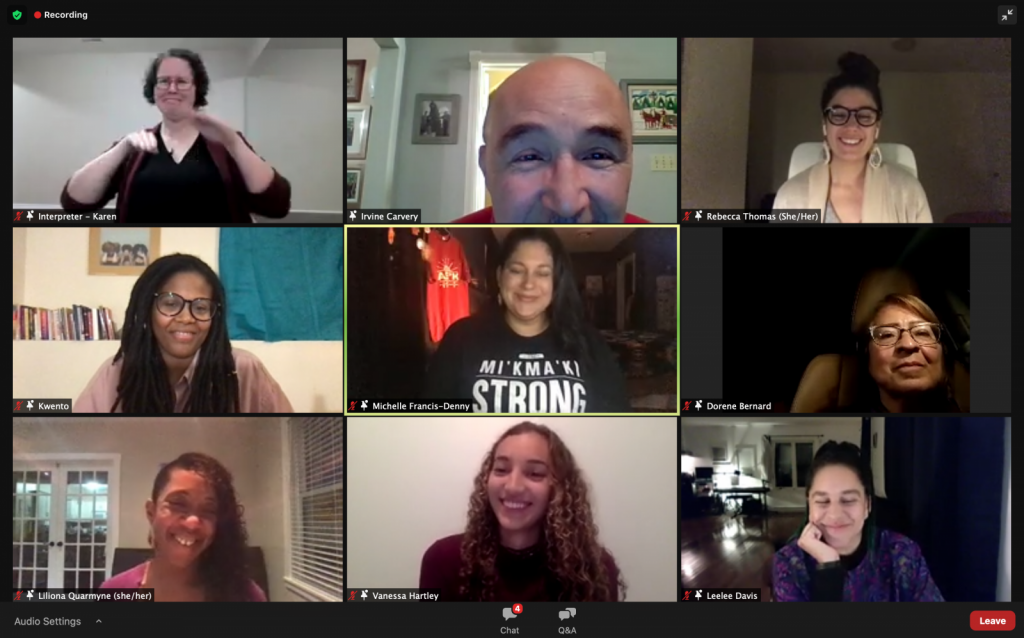

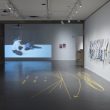
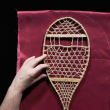
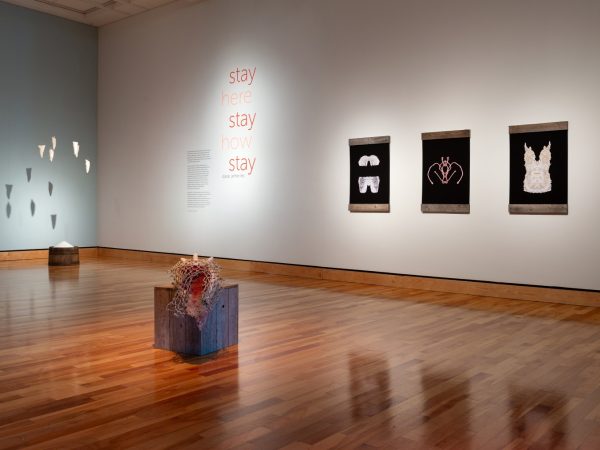
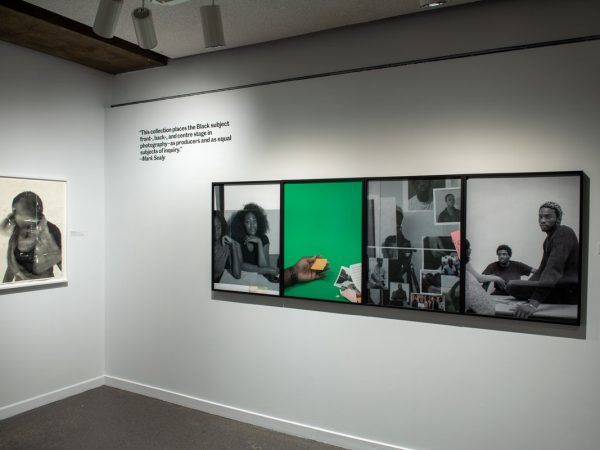
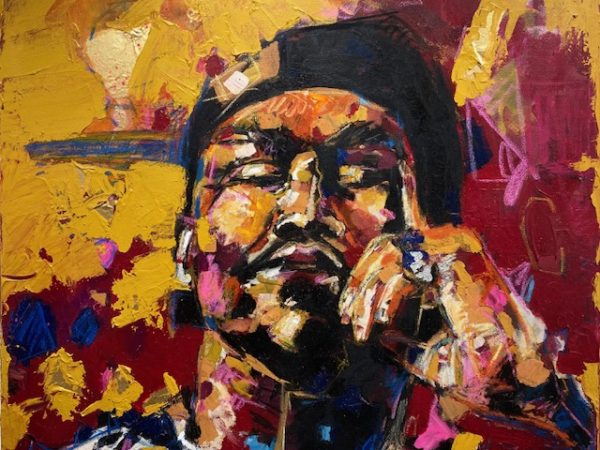
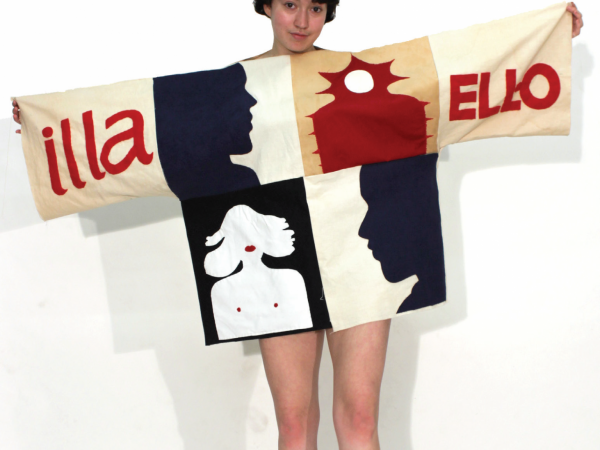
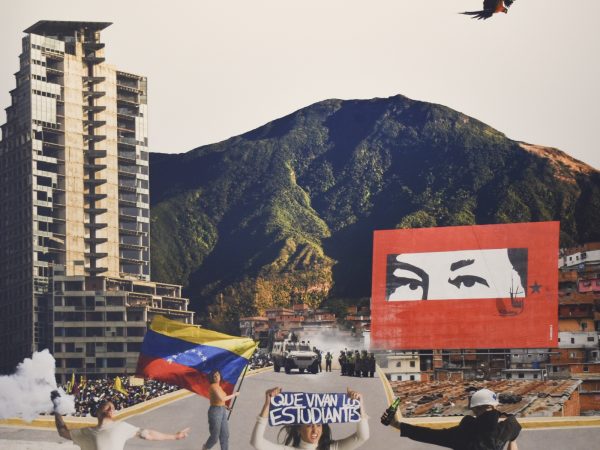
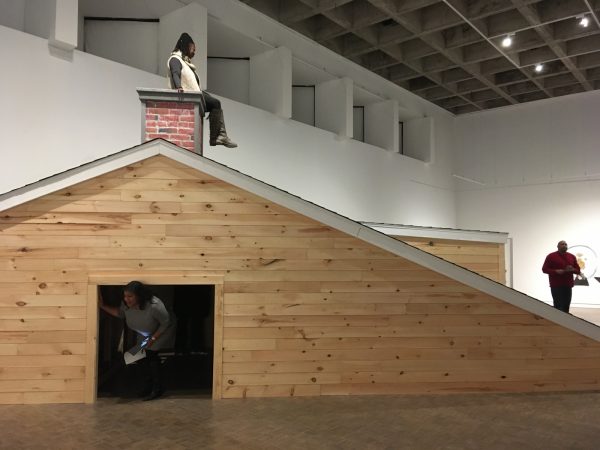
Leave a Reply